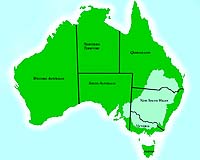| . |  |
. |
Moffett Field CA (SPX) May 19, 2010 Tiny variations in the isotopic composition of silver in meteorites and Earth rocks are helping scientists put together a timetable of how our planet was assembled beginning 4.568 billion years ago. The new study, published in the journal Science, indicates that water and other key volatiles may have been present in at least some of Earth's original building blocks, rather than acquired later from comets, as some scientists have suggested. Compared to the solar system as a whole, Earth is depleted in volatile elements, such as hydrogen, carbon, and nitrogen, which likely never condensed on planets formed in the inner, hotter, part of the solar system. Earth is also depleted in moderately volatile elements, such as silver. "A big question in the formation of the Earth is when this depletion occurred," says co-author Richard Carlson of the Carnegie Institution for Science's Department of Terrestrial Magnetism. "That's where silver isotopes can really help." Silver has two stable isotopes, one of which, silver-107 was produced in the early solar system by the rapid radioactive decay of palladium-107. Palladium-107 is so unstable that virtually all of it decayed within the first 30 million years of the solar system's history. Silver and palladium differ in their chemical properties. Silver is the more volatile of the two, whereas palladium is more likely to bond with iron.These differences allowed the Carnegie researchers, which included Carlson, lead author Maria Schonb�chler (a former Carnegie Institution postdoctoral scientist now at the University of Manchester), Erik Hauri, Mary Horan, and Tim Mock to use the isotopic ratios in primitive meteorites and rocks from Earth's mantle to determine the history of Earth's volatiles relative to the formation of Earth's iron core. Other evidence, specifically from hafnium and tungsten isotopes, indicates that the core formed between 30 to 100 million years after the origin of the solar system. "We found that the silver isotope ratios in mantle rocks from the Earth exactly matched those in primitive meteorites," says Carlson. "But these meteorites have compositions that are very volatile-rich, unlike the Earth, which is volatile-depleted." The silver isotopes also presented another riddle, suggesting that the Earth's core formed about 5-10 million years after the origin of the solar system, much earlier than the date from the hafnium-tungsten results.The group concludes that these contradictory observations can be reconciled if Earth first accreted volatile-depleted material until it reached about 85% of its final mass and then accreted volatile-rich material in the late stages of its formation, about 26 million years after the solar system's origin. The addition of volatile-rich material could have occurred in a single event, perhaps the giant collision between the proto-Earth and a Mars-sized object thought to have ejected enough material into Earth orbit to form the Moon. The results of the study support a 30-year old model of planetary growth called "heterogeneous accretion," which proposes that the Earth's building blocks changed in composition as the planet accreted. Carlson adds that it would have taken just a small amount of volatile-rich material similar to primitive meteorites added during the late stages of Earth's accretion to account for all the volatiles, including water, on the Earth today. "Though I accept that about 85 per cent of the Earth's mass was built without volatile elements, the rest of it was- and that's quite an important difference in our understanding of the Earth's geological history," said Schonb�chler. "We don't now need any theories about how water came to Earth - such as comets and asteroids - it was most likely here almost from the beginning. And water is what made Earth habitable for life."
Share This Article With Planet Earth
Related Links Carnegie Institution for Science's Department of Terrestrial Magnetism Water News - Science, Technology and Politics
 Murray-Darling Water To Flow Where It Is Needed Most
Murray-Darling Water To Flow Where It Is Needed MostCanberra, Australia (SPX) May 19, 2010 Canberra, Australia (SPX) May 19, 2010 A new CSIRO report will help ensure the delivery of maximum ecological benefits from water allocations in the Murray-Darling Basin (MDB). Funded by the National Water Commission, the report; Ecological Outcomes of Flow Regimes in the Murray-Darling Basin, provides information that will assist water managers to improve and justify delivery of environm ... read more |
|
| The content herein, unless otherwise known to be public domain, are Copyright 1995-2010 - SpaceDaily. AFP and UPI Wire Stories are copyright Agence France-Presse and United Press International. ESA Portal Reports are copyright European Space Agency. All NASA sourced material is public domain. Additional copyrights may apply in whole or part to other bona fide parties. Advertising does not imply endorsement,agreement or approval of any opinions, statements or information provided by SpaceDaily on any Web page published or hosted by SpaceDaily. Privacy Statement |